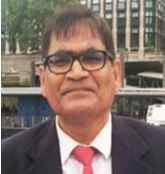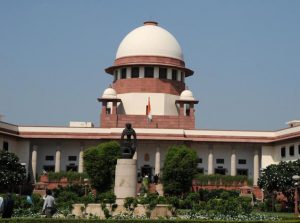 Professor Satya Narayan Misra* in Bhubaneswar, November 10, 2022: In a split verdict (3:2), the Supreme Court upheld the 103rd amendment to the Constitution providing 10% reservation in employment to Economically Weaker sections of the society.
Professor Satya Narayan Misra* in Bhubaneswar, November 10, 2022: In a split verdict (3:2), the Supreme Court upheld the 103rd amendment to the Constitution providing 10% reservation in employment to Economically Weaker sections of the society.
The Constitution bench was adjudicating three issues viz, Can the reservation be provided on economic criteria? Can SC/ ST/ OBC be excluded from EWS? Can EWS reservations exceed the 50% limit for SC/ ST/OBC?
The appellants’ main contention was that reservation on EWS criteria will offend the basic structure doctrine, an offshoot of the Keshavananda Bharati Verdict (1973). All five judges agreed with the first question that economic criteria can be a basis for reservation. The dissension of CJ Lalit & Justice Bhatt is for excluding SC/ST/ non-creamy layer of OBC from the lens of reservation on the basis of economic criterion.
The first slugfest between the government and the Supreme Court happened in the Champakam Dorairajan case (1951) when the court struck down reservations in admission to medical colleges on the basis of caste in Madras. Article 46 seeks to promote with special care the educational and economic interests of weaker sections and in particular SC& ST.
The court was of the view that Art 46 being a non-justiciable directive to the state, caste-based reservation cannot override a fundamental right Art 15 which mandates no discrimination on the basis of caste, gender, and religion. Subsequently, the government has introduced a slew of amendments to Art 15 & 16 to provide reservations in admission to educational institutions and employment to SC, ST, and OBC.
The Supreme Court has consistently upheld amendments from time to time for reservation (Balaji, Indra Sawney, Nagraj, Ashok Thakur), with the proviso that total reservation should not exceed 50%, non-creamy layer of OBC only will get the benefit of reservation & not adequately represented.
While all these reservations were vertical in nature, like SC, ST, and OBC, the 103rd amendment is horizontal in character, with the benefit going to economically weaker sections of the General Category, irrespective of the caste they belong to. The trigger for this initiative came from the mothballed Gen Sinho Committee Report (2010) which brought out how people below the poverty line in General Category were as high as 18.7%. Poverty, as per the report is not caste-based but socio-economic conditioned. The new insertions 15(6) & 16(6) provide a window for the EWS in the GC to catch up with the economically advantaged sections of society in terms of education & employment.
Responding to the constant invocation of basic structure doctrine, the judges aver that the basic structure of the constitution is a sum total of basic features like democracy, secularism, and independence of the judiciary. Justice Bhat writes that only when a hostile constitutional amendment is initiated which strikes at the very identity of the Constitution, like judicial review, free & fair elections, federalism, secularism, and Parliamentary form, the Supreme Court will intervene & strike them as ultra vires. Quoting the Minerva Mills judgment (1980) the judges observe that equality must be real and substantive.
 For a classification to be reasonable, the objective has to be just and there should be a reasonable nexus to the object sought to be achieved. For achieving real & substantive equality, affirmative action and reservation are required. Backwardness and inadequacy of representation, the Supreme Court in the Nagraj Case said, justified even reservation in promotion for SC& ST.
For a classification to be reasonable, the objective has to be just and there should be a reasonable nexus to the object sought to be achieved. For achieving real & substantive equality, affirmative action and reservation are required. Backwardness and inadequacy of representation, the Supreme Court in the Nagraj Case said, justified even reservation in promotion for SC& ST.
The majority verdict harp on economic disability as a reasonable basis for affirmative action. They quoted Ambedkar who wrote: ‘Constitution is committed to the principle of economic democracy as a complement to political democracy.’ Article 38 (Economic justice) & Art 46 (promotion of economic interests of weaker section) lie at the heart of ushering in economic democracy.
The judges also invoke Goal 1 of SDG which aims at ending poverty in all forms everywhere. They find the classification between EWS from GC and other weaker sections reasonable. They also support breaching the 50% limit as reasonable. They quote Justice Krishna Iyer in support who wrote: ‘Arithmetic limit of 50% cannot be pressed too far. Reservation may not be so excessive as to be excessive.’
The minority viewpoint penned by Justice Bhat asserts that the idea of equality is tethered to non-discrimination. Differentiating the poorest segment as one segment and the other poorest who are subject to caste stigma is an exercise to delude ourselves that getting social and economic backwardness reservations are somewhat more fortunate.
Such classification is contrary to the essence of equal opportunity. The judges refer to the new criteria of the Multi-Dimensional Poverty Index which takes a composite view of education, health, and standard of living. As per the NSSO 2004-2005 survey, % of BPL for SC, ST, OBC & GC is 38%, 48%, 33% & 18% respectively. Without economic emancipation, liberty and equality are mere platitudes, empty promises ‘tied to ropes.
‘The exclusion clause that keeps out the benefit of economic reservation from OBC, SC, ST strikes a death knell to equality principle that permeates equality code & nondiscrimination principle. Justice Bhat writes that the net effect of the exclusion principle is Orwellian, where some are more equal than others.
Ambedkar had observed that reservation is temporary, else ‘it would eat up the roots of equality. He would squirm in his grave, the way the reservation conundrum has proliferated from caste to class, with a huge political bonanza for the BJP, which has found a solid vote bank amongst the EWS of upper-caste, who always felt done down by lower-caste advantage in reservation politics.
Abdicating the equality principle from the BPL lens is likely to be contested again. CJI Lalit, who is part of the minority verdict can profitability quote Justice Evans who wrote: Dissent is an appeal to the brooding spirit of the law, when a later decision may correct an error in to which the dissenting judge believes the court to have been betrayed.’. Besides, with the cap of reservation being raised to 59.5% now, India is perched on a big irony, where the judges endorse reservation whereas the economic system is predicated on market competition, efficiency, and merit.
 The judgment has skirted issues like the reasonability of Rs 8 lakh per year for being considered economically weak when the Below Poverty Line is reckoned at Rs 32 per day. There is a surprising similarity with the creamy layer criteria for qualifying for reservation in the OBC category. Also, the concept of the creamy layer not applying to SC & ST for reservation appears to be palpably discriminatory. Putting SC/ ST as a separate class does not cut the ice of equity.
The judgment has skirted issues like the reasonability of Rs 8 lakh per year for being considered economically weak when the Below Poverty Line is reckoned at Rs 32 per day. There is a surprising similarity with the creamy layer criteria for qualifying for reservation in the OBC category. Also, the concept of the creamy layer not applying to SC & ST for reservation appears to be palpably discriminatory. Putting SC/ ST as a separate class does not cut the ice of equity.
The Committee appointed under CJI (Retired) Balakrishna to examine the demands of Dalits who have converted to Christianity or Islam for reservation needs to be resolved early. It may be recalled that Justice Ranganathan Committee (2007) had recommended that SC should be religion-neutral. India seems to have slipped into a slippery path of reservation, either on class or caste irreversibly, with religion waiting in the wings for its slice of the pie. The Supreme Court has become the pied piper of reservation overlooking open merit-based competition which is the life breath of liberal democracy.
* Prof Misra teaches Constitutional Law


Leave a Reply
Be the First to Comment!